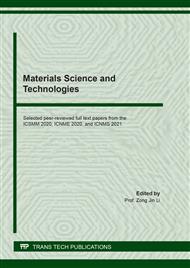[1]
J. Fleddermann, J. Susewind, H. Peuschel, M. Koch, I. Tavernaro, A. Kraegeloh., Distribution of SiO2 nanoparticles in 3D liver microtissues, Int. J. Nanomedicine, 14 (2019)1411–1431.
DOI: 10.2147/ijn.s189888
Google Scholar
[2]
X. Ding, K. Yu, Y. Jiang, H.B., H. Zhang and Z. Wang, A novel approach to the synthesis of hollow silica nanoparticles, Mater. Lett., 58 (27-28) (2004) 3618-3621.
DOI: 10.1016/j.matlet.2004.07.008
Google Scholar
[3]
O. M. Sadek, S. M. Reda, R. K. Al-Bilali, Preparation and characterization of silica and clay-silica core-shell nanoparticles using sol-gel method, Adv. Nanopart., 2 (2013) 165-175.
DOI: 10.4236/anp.2013.22025
Google Scholar
[4]
D. Zahao, P. Yang, Q. Huo, B.F. Chemelka, G.D. Stucky, Topological construction of mesoporous materials, Curr. Opin. Solid State Mater. Sci., 3 (1) (1998) 111-121.
Google Scholar
[5]
K. Okada, A. Shimai, T. Takei, S. Hayashi, A. Yasumori, K.J.D. Mac-Kenzie, Preparation of microporous silica from metakaolinite by selective leaching method, Microporous and Mesoporous Mater., 21 (4-6) (1998) 289-296.
DOI: 10.1016/s1387-1811(98)00015-8
Google Scholar
[6]
B. Lee, Y. Kim, H. Lee, J. Yi, Synthesis of functionalized porous silicas via templating method as heavy metal ion adsorbents: the introduction of surface hydrophilicity onto the surface of adsorbents, Microporous Mesoporous Mater., 50 (1) (2001) 77-90.
DOI: 10.1016/s1387-1811(01)00437-1
Google Scholar
[7]
F. He, R. Zhuo, L. Liu, D. Jin, J. Feng, X.Wang, Immobilized lipase on porous silica beads: preparation and application for enzy matic ring-opening polymerization of cyclic phosphate, React. Funct. Polym., 47 (2) (2000) 153-158.
DOI: 10.1016/s1381-5148(01)00027-x
Google Scholar
[8]
J. F. Chen, H. M. Ding, J. X. Wang, L. Preparation and characterization of porous hollow silica nanoparticles for drug delivery application, Biomaterials,25 (4) (2004) 723-727.
DOI: 10.1016/s0142-9612(03)00566-0
Google Scholar
[9]
Z. Zhang, S. Dai, X. Fan, D. A. Blom, S. J. Pennycook, Y. J. Wei, Controlled synthesis of CdS nanoparticles inside ordered mesoporous sikica using ion-exchange reaction. The Journal of Physical Chemistry B, 105 (29) (2001) 6755-6758.
DOI: 10.1021/jp010541q
Google Scholar
[10]
H.D. Jang, Experimental study of synthesis of silica nanoparticles by a bench-scale diffusion flame reactor, Powder Technol., 119 (2) (2001)102-108.
DOI: 10.1016/s0032-5910(00)00407-1
Google Scholar
[11]
W. Stober, A. Fink, Controlled growth of monodisperse silica spheres in themicron size rang, J. Colloid Interface Sci., 26 (1) (1968) 62-69.
DOI: 10.1016/0021-9797(68)90272-5
Google Scholar
[12]
W. Zhu, Y. Han and L. An, Synthesis of ordered mesostructured silica nanotubal arrays, Microporous and Mesoporous Mater., 84, (1-3) (2005) 69-74.
DOI: 10.1016/j.micromeso.2005.04.020
Google Scholar
[13]
H. Fang, M. Zhang, Facile synthesis of ordered large- pore mesoporous silica thin film with symmetry using n-butanol as the cosurfactant, J. Non Cryst. Solids, 352 (21-22) (2006) 2279-2283.
DOI: 10.1016/j.jnoncrysol.2006.02.057
Google Scholar
[14]
S. Shahidi, A. Jamali, S. D. Sharifi, H. Ghomi, In-situ synthesis of CuO nanoparticles on cotton fabrics using spark discharge method to fabricate antibacterial textile, Journal of Natural Fibers, 15 (6) (2017) 1-12.
DOI: 10.1080/15440478.2017.1376302
Google Scholar
[15]
M. I. Khan, S. S. Alam, J. Fatema, and M. S. Islam, Waterproof and oil repellent treatments of cotton fabric, J. Text. Sci. Technol., 6 (202) 59-80.
Google Scholar
[16]
Z. N. Jameel, A. J. Haider and S. Y. Taha, Synthesis of TiO2 Nan particles by using sol-gel method and its applications as antibacterial agents, Eng. Technol. J., 32 (3) (2014) 418-426.
Google Scholar
[17]
J. N. Hasnidawani, H. N. Azlina, H. Norita, N. N. Bonnia, S. Rati, E. S. Ali, Synthesis of ZnO nanostructures using sol-gel method, Procedia Chem., 19 (2016) 211-216.
DOI: 10.1016/j.proche.2016.03.095
Google Scholar
[18]
H. Elbushra, M. Ahmed, H. Wardi, N. Eassa, Synthesis and characterization of TiO2 using sol-gel method at different annealing temperatures, Afr. Mater. Res. Soc., 3 (42-43)(2018)2527-2535.
DOI: 10.1557/adv.2018.230
Google Scholar
[19]
R.Vacassy, R.J. Flatt, Synthesis of microporous silica spheres, J. Colloid Interface Sci., 227 (2) (2000) 302-315.
DOI: 10.1006/jcis.2000.6860
Google Scholar


